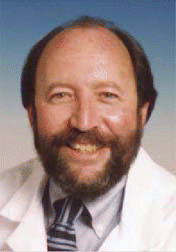Two abstracts presented at the 2007 Combined Otolaryngology Spring Meeting (COSM) reflect where the news lies with the subject of tracheotomy: raising the index for suspicion for tracheal stenosis following percutaneous tracheotomy1 and better educating non-otolaryngologists who manage tracheotomy patients.2
Explore This Issue
November 2007Potential for Complications
In many medical institutions, percutaneous tracheotomy (PCT) techniques have become popular because of the advantages of this technique over open tracheotomy, which include cost effectiveness, safety, and ease and speed of performance. The use of PCT at the patient’s bedside means decreasing the need to transport a very ill patient to the operating theater. Studies comparing open tracheotomy and PCT have not shown a significant difference in morbidity and mortality between the two procedures. Closer attention to the duration of tracheotomy tube placement and the size of tracheotomy tubes has reduced rates of long-term sequelae. However the potential for the development of tracheal stenosis, a dangerous complication, requires a more careful look, said otolaryngologists at Thomas Jefferson University Hospital in Philadelphia.
“This institution has long history of dealing with tracheal stenosis,” said Maurits Boon, MD, an attending physician at Thomas Jefferson. Louis H. Clerf, MD, who was one of the founders of otolaryngology and a professor at Jefferson Medical College, was instrumental in recognizing some of the complications that occur with high tracheotomy and describing how the technique should be performed.
In 2006 eight patients were referred to the otolaryngology–head and neck surgery department for management of tracheal stenosis following percutaneous dilational tracheotomy. In each case CT findings of anterior tracheal ring or cricoid compression and destruction were noted. In all cases, endoscopy revealed stenosis secondary to anterior tracheal wall or anterior cricoid collapse. Revision operations were necessary to correct the damaged tracheal wall due to narrowing of the tracheal lumen.
The impetus for examining the potential association of tracheal stenosis with PCT has its parallel in earlier experimental studies. “In the 1970s [investigators] did dog studies in which they made a cross incision in the trachea and [inserted] a trach tube,” said Dr. Boon. “They had a very high rate of stenosis because the procedure crushed a tracheal ring into the airway and then [it scarred over]. Our theoretical concern is that we are now doing very similar things with percutaneous tracheotomy…and in fact we have seen some patients after percutaneous tracheotomy who have developed significant stenoses that in some respects have been hard to correct.”
The Thomas Jefferson team’s research objective was not to refute the results of studies demonstrating the advantages of PCT—that its complication rates are equivalent or better than those for the open technique—but rather to alert their colleagues that there may be relative downsides to the use of PCT.
“In the long term we may be seeing more complications than have been recognized before and it’s something we have to examine a little more comprehensively,” said Dr. Boon. Because their initial research was a retrospective study using only a small sample of patients, they are now developing a prospective study that will allow greater methodologic control.
Training for Performance of Tracheotomy
The training of residents and others who will perform tracheotomies include a few main teaching points that are easily summarized, said Dr. Boon. For open tracheotomy, which is not a challenging procedure technically, the main point is recognizing which technique to choose—either removing a small portion of a tracheal ring or making a Bjork flap and then sewing the invaginated ring to the subcutaneous tissues in order to create a track. “It is important to make the opening in an appropriate location, not too high or too low,” said Dr. Boon.
Regarding percutaneous tracheotomy, Dr. Boon considers the most important teaching points to be appropriate patient selection and the importance of simultaneous adjunctive bronchoscopy. “The person doing the bronchoscopy probably has the most important position in the whole procedure: to watch and recognize when things aren’t going according to plan, when there is too much force required to push the trach tube in, and when there is a fracture of the tracheal ring,” he said.
A third major teaching point involves the recognition of problems in the postoperative period. “A lot of patients are misdiagnosed, often with asthma,” said Dr. Boon. “The trach tube gets removed and the patient keeps going to the emergency department with complaints of airway problems; they keep getting treated for asthma [or other conditions] and aren’t getting better. Often after many weeks, they get referred to us and we recognize they have a tracheal stenosis.”
Educating Those Who Manage Tracheostomy Patients
“Most otolaryngologists are considered the airway and tracheotomy experts in their hospitals,” said Bradley Schiff, MD, Assistant Professor in the Department of Otorhinolaryngology–Head and Neck Surgery at Montefiore Medical Center at Albert Einstein College of Medicine in Bronx, NY. “But outside of otolaryngology departments, most general MDs, nurses, ICU staff, and respiratory therapists are often not comfortable managing tracheostomies. They are often unsure of what they are dealing with and unsure of the needs of tracheostomy patients.”
A multidisciplinary committee composed of surgeons, intensivists, and nurses at Montefiore undertook a systematic review of monthly morbidity and mortality conference records and retrospective chart reviews to identify commonalities in tracheotomy-related mortalities. In alignment with Accreditation Council for Graduate Medical Education core competencies, otorhinolaryngology residents were included at every step. From July 2004 to July 2005, eight post-tracheotomy mortalities were identified, an increase of more than 100% over each of the three previous years.
To address the problems that were brought to light, the team worked to establish a plan whereby tracheotomy patients were placed postoperatively in one of three designated units in which experienced nurses and house staff were always available, and the Department of Otorhinolaryngology–Head and Neck Surgery developed and implemented a hospital-wide educational initiative aimed at increasing knowledge of tracheotomy-related issues.
One reason that respiratory therapists, registered nurses, and medical house staff were often confused when managing tracheotomy patients was that a variety of tracheotomy devices were being used throughout the institutional system. After their research, a hospital-wide uniform tracheotomy tube policy was implemented for all the facilities in the system. “We may not hear [feedback] about complications,” Dr. Schiff said, “but from what we see in our morbidity and mortality conference, we have not had any confusion since they made the change.”
The Montefiore team devised a system for educating the general medical population. “In our department, we noticed that there was an increase in what we thought were complications on the medical floors of the hospital [in regard to] managing patients with a tracheotomy,” said Dr. Schiff. The team thought it was likely that these nurses and other providers did not understand the basics—why a tracheotomy is done, how a tracheotomy is done, and how patients with tracheotomies are cared for.
“People who don’t have a lot of practice or exposure to tracheotomy patients may be afraid to manage these patients,” said Marvin P. Fried, MD, Professor and University Chairman of the Department of Otorhinolaryngology–Head and Neck Surgery at Montefiore Medical Center, Albert Einstein College of Medicine. Therefore, the department developed a procedures programatica that was an educational tool. Initially designed as a PowerPoint presentation, it was given to residents, the ICU staff, respiratory therapists and nurses on certain floors that had issues with tracheotomies. Because feedback was positive, they took it one step further. “One of our residents has currently completed a research project with a preliminary DVD for training, which is absolutely magnificent,” said Dr. Fried. “We hope to share that with other hospitals for their educational benefit.”
The DVD program includes anatomy, indications for tracheotomy, various types of trach tubes used, a video clip of the procedure being performed, and directions for managing postoperative complications. In Dr. Schiff’s view, this information has not been widely summarized in other educational offerings. “In otolaryngology textbooks, they’re going to skip the basics and focus on the details,” he said. “In general medical textbooks, they may skip the details and focus on the basics. One advantage of an interactive DVD is that a person can get out of it whatever they’re looking for.”
Although the DVD is almost complete, production and distribution will depend on locating funding. There is little doubt that there is a need for it, concluded Dr. Schiff: “We are the main academic hospital in a major medical school-affiliated health center; if we have issues, I would presume there are issues at the majority of hospitals across the country.”
Educational Aspects of Tracheotomy Management
“It is our responsibility as surgeons not only to perform the tracheotomy procedure, but to educate those who are going to be taking care of the patient afterward,” said Dr. Fried. “Involving residents, nurses, hospital administration, pulmonary care providers, and intensive care providers has a lot of beneficial effects. We’ve seen a big difference when we’ve taught people appropriately,” said Dr. Fried. Providers who take care of patients with tracheotomies must be desensitized to let go of any fright they have of the device. In Dr. Fried’s view, the top educational aspects for managing tracheotomies include:
- Understanding why the patients have had a tracheotomy performed.
- Understanding relevant basic anatomy.
- Doing whatever is necessary to help providers who manage these patients to overcome their fears.
References
- Christenson TE, Spiegel JR, Boon MS, Artz GJM. Tracheal stenosis following placement of percutaneous dilational tracheotomy. COSM meeting abstract presentation 2007.
- Ostrower ST, Alexander RE, Fried MP, Parikh SR, Schiff BA. Reducing post-tracheotomy morbidity and mortality in the hospital—implementation of the core competencies in resident education. COSM meeting abstract presentation 2007.
©2007 The Triological Society


Leave a Reply